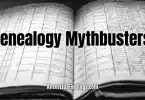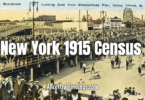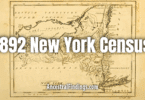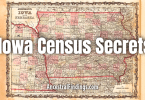The 1870 U.S. Census is a milestone for many family historians. For those tracing African American ancestry, it often marks the very first time their ancestors appear in a public federal record by name. The names are handwritten clearly on the page—no longer separated, omitted, or counted as property. For the first time, individuals who were born into slavery are seen on equal footing with every other American, listed not as someone’s possession but as someone’s parent, spouse, child, worker, or head of household.
But the moment of discovery in 1870 almost always leads to a question: What about before? How do I find my ancestors in the years before emancipation? Who were they, and where were they living before the war?
Finding those answers requires patience and care—but the records are out there. The 1870 census is often the starting place for a powerful journey backward through time. The steps that follow can help you begin piecing that story together.
Starting with the 1870 Census
Begin with what you know. Locate your ancestor in the 1870 census and study the entire household. Look closely at names, ages, and birthplaces. You’ll want to pay attention to everyone in the household, not just the head of the household. A grandmother born in Virginia, living with a younger couple in Georgia, may offer hints about where the family had once lived or been moved. An unfamiliar surname nearby might belong to the former enslaver or a previously separated sibling or cousin.
The birthplace column is especially valuable. It gives you a direction to look when tracking migration or forced movement, during slavery. If the entire household lists the same state of birth, that may suggest the family stayed in one area. If birthplaces span several states, the family’s history may include relocation between plantations, slave sales, or post-war migration.
Occupations and property values can also hold subtle clues. A formerly enslaved man, listed as a farmer with no land, may have been sharecropping on the same land where he once worked. A woman listed as a cook or seamstress might appear in a Freedmen’s Bureau labor contract. Small property values for older freed people may reflect land they acquired after emancipation or possibly a homestead claim.
Building the Link Between 1870 and 1860
Once you know who you’re looking for, the next challenge is reaching back beyond the Civil War—specifically, to 1860. The challenge, of course, is that formerly enslaved individuals were not named in the population census. Instead, they were counted in separate slave schedules under the name of the enslaver. These records list only age, sex, and color.
But the clues still exist. You can start by searching the 1860 slave schedule in the same county—or even the same neighborhood—where your ancestor was living in 1870. Look for people listed as owning enslaved individuals of the same age and gender as your ancestor. It’s not definitive proof, but it’s often the first breadcrumb.
Also, compare surnames. Many formerly enslaved people took the surname of their last enslaver or sometimes of an admired figure or local landowner. If your ancestor shares a surname with a local white family, especially one that appears on the 1860 slave schedule, there may be a connection.
Even more telling is geography. If the formerly enslaved person in 1870 is living next door to—or working for—the same family that held enslaved people in 1860, that’s a clue worth following.
Searching the Freedmen’s Bureau Records
Between 1865 and 1872, the Freedmen’s Bureau created a wide variety of records to support newly freed individuals as they built new lives. These documents often serve as a bridge between the 1860s and the 1870s.
In many places, the Bureau recorded marriages that had taken place during slavery but were not legally recognized until after emancipation. These registers may include the names of spouses, children, former enslavers, and even witnesses. Labor contracts, which formalized work agreements between freed people and landowners, sometimes list entire families. School records include names of children, ages, and attendance at Freedmen’s schools. Hospital records, ration lists, and reports of abuse or violence may consist of family members by name and offer vivid details about the early years of freedom.
These records are often organized by state, then by Bureau district, and can be found on FamilySearch, the Freedmen’s Bureau Project, and through the National Archives.
Exploring the Southern Claims Commission
Another overlooked set of records is the Southern Claims Commission files. Between 1871 and 1880, individuals in the South who had remained loyal to the Union could apply for compensation for property taken or destroyed during the war. Each application includes sworn testimony—sometimes dozens of pages—and many mention formerly enslaved people by name.
Even if your ancestor didn’t file a claim, they may have been listed as a witness, neighbor, or subject of testimony. These records often include first-hand accounts of life before, during, and after the war. They may describe where people lived, how they were treated, and who they lived with. These details can be gold for someone trying to place a formerly enslaved person within a specific household or community before 1870.
Looking Into Pension Files and Military Records
If your ancestor—or a member of their household—served in the Union Army during the Civil War, a pension application may exist. Over 180,000 Black men served in the United States Colored Troops (USCT). Many of their pension files are rich with personal details.
Applications often include marriage records, children’s names and birthdates, affidavits by neighbors, and even letters. Widows who applied for pensions had to prove the marriage and sometimes included family Bible pages or the names of ministers and witnesses. These records are deeply personal and can fill in the missing years before 1870 with clarity and emotion.
Turning to Churches and Community Roots
After emancipation, churches became the heart of many Black communities. Many newly freed families founded their congregations—places where names were written down, relationships were recorded, and communities kept track of their members.
Baptism, marriage, and burial records may survive from the 1860s and 1870s in churches affiliated with denominations such as the AME, Baptist, or Methodist churches. These institutions were often connected to early Black schools as well, and their records may also include teacher lists, student rolls, and early membership registers.
If you know where your ancestors lived, it’s worth contacting local congregations or regional historical societies to inquire about the records that still exist.
Understanding Names After Emancipation
It’s essential to recognize that many names changed after the Civil War. Some individuals chose to keep the name associated with their former enslaver. Others chose new surnames to mark their independence. Some adopted names of biblical figures, trades, or notable leaders.
This means you may see name shifts between 1870 and 1880, even within the same family. A man listed as Frank Johnson in 1870 might appear as Frank Green in 1880—or vice versa. Tracking children, neighbors, and siblings can help you keep your search on track when surnames change. Pay attention to ages, birthplaces, and relationships that stay consistent, even if the name doesn’t.
Walking Back Through Time, Carefully
Tracing formerly enslaved ancestors before 1870 requires a different kind of research—slower, more interpretive, and often based on connecting patterns rather than finding exact matches. But it can be done. And when it is, it’s powerful.
Take your time. Keep careful notes. Look at everyone in the household, and don’t ignore neighbors who might be related. The records from this time are incomplete, yes—but not silent. They speak in layers, and with care, you can hear them.
When you find your ancestor in the 1870 census—when you say their name aloud from that page—you are part of a sacred act of remembering. And when you walk them back through time, piece by piece, you bring them even further into the light.






